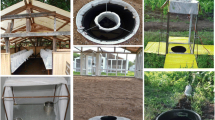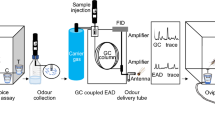Abstract
The response of Culex mosquitoes to (5R,6S)-6-acetoxy-5-hexadecanolide (the synthetic oviposition pheromone, SOP), emanations from soakage pit water (SPW), and grass infusions (GI) was studied in pit latrines in Muheza, Tanzania. Water treated with the synthetic oviposition pheromone received more egg rafts of Culex quinquefasciatus Say and Cx. cinereus Theobald than did the untreated water (P < 0.001). The residual activity of SOP did not decrease over a nine-day period, with the geometric mean number of egg rafts laid in the SOP-treated water varying daily between 2.5 and 8.9 as compared to 0.1–1.6 egg rafts laid in tap water. However, SOP did not attract ovipositing mosquitoes to nonbreeding sites, and both treatment and control received few eggs. SPW and GI attracted ovipositing Cx. quinquefasciatus, Cx. cinereus, and Cx. tigripes Grandpré and de Charmoy with the number of eggs rafts deposited in bowls containing SPW or GI being larger than that deposited in bowls with tap water (P < 0.05). More egg rafts of Cx. quinquefasciatus were deposited in SOP-treated water than in SPW (P < 0.05). When SOP was compared with SOP + SPW, more egg rafts of Cx. quinquefasciatus were deposited in bowls with the latter combination than in bowls containing SOP or SPW only (P < 0.05), indicating a synergistic effect between SOP and SPW. Similarly, when SOP-treated water and GI were compared with SOP + GI, more egg rafts of Cx. quinquefasciatus were laid in the latter bowl, indicating a synergistic effect between SOP and GI. The result suggest that the combined use of SOP and organically enriched water can be employed in monitoring of Cx. quinquefasciatus for control programs. This is the first record of the attraction of Cx. cinereus and Cx. tigripes to oviposition stimuli.
Similar content being viewed by others
REFERENCES
Beehler, J. W., Millar, J. G., and Mulla, M. S. 1994a. Protein hydrolysates and associated bacterial contaminants as oviposition attractants for the mosquito Culex quinquefasciatus. Med. Vet. Entomol. 5:381-385.
Beehler, J. W., Millar, J. G., and Mulla, M. S. 1994b. Field evaluation of synthetic compounds mediating oviposition in Culex mosquitoes (Diptera: Culicidae). J. Chem. Ecol. 20:281-291.
Bentley, M. D., and Day, J. F. 1989. Chemical ecology and behavioral aspects of mosquito oviposition. Annu. Rev. Entomol. 34:401-421.
Blackwell, A., Mordue (Luntz), A. J., Hansson, B. S., Wadhams, L. J., and Pickett, J. A. 1993. A behavioural and electrophysiological study of oviposition cues for Culex quinquefasciatus. Physiol. Entomol. 18:343-348.
Bruno, D. W., and Laurence, B. R. 1979. The influence of the apical droplet of Culex egg rafts on oviposition of Culex pipiens fatigans (Diptera: Culicidae). J. Med. Entomol. 16:300-305.
Dawson, G. W., Mudd, A. L., Pcikett, J. A., Pile, M. M., and Wadhams, J. 1990. Convenient synthesis of mosquito oviposition pheromone and a highly fluorinated analog retaining biological activity. J. Chem. Ecol. 16:1779-1789.
Edwards, F. W. 1942. Mosquitoes of the Ethiopian Region III. Culicine Adults and Pupae. Adlard and Sons, London, 499 pp.
Gillett, J. D. 1972. Common African Mosquitos and their Medical Importance. William Heinemann Medical Books, London, 106 pp.
Hwang, Y., Mulla, M. S., Chaney, J. D., Lin, G., and Xu, H. 1987. Attractancy and species specificity of 6-acetoxy-5-hexadecanolide, a mosquito oviposition attractant pheromone. J. Chem. Ecol. 13:245-252.
Ikeshoji, T., Umino, T., and Hirakoso, S. 1967. Studies on mosquito attractants and stimulants. Part IV. An agent producing stimulative effects for oviposition of Culex pipiens fatigans in field water and stimulative effects of various chemicals. Jpn. J. Exp. Med. 37:61-69.
Ikeshoji, T., Saito, K., and Yano, A. 1975. Bacterial production of the ovipositional attractants for mosquitoes on fatty acid substrates. Appl. Entomol. Zool. 10:239-242.
Irving-Bell, R. J., Okoli, E. I., Diyelong, D. Y., Lyimo, E. O., and Onyia, O. C. 1987. Septic tank mosquitoes: Competition between species in central Nigeria. Med. Vet. Entomol. 1:243-250.
Kline, D. L. 1994. Introduction to symposium on attractants for mosquito surveillance and control. J. Am. Mosq. Control Assoc. 10:253-257.
Laurence, B. R., and Pickett, J. A. 1982. erythro-6-Acetoxy-5-hexadecanolide, the major component of a mosquito oviposition attractant pheromone. J. Chem. Soc. Chem. Commun. 1982:59-60.
Laurence, B. R., and Pickett, J. A. 1985. An oviposition pheromone for Culex quinquefasciatus Say (Diptera: Culicidae). Bull. Entomol. Res. 75:283-290.
Laurence, B. R., Mori, K., Otsuka, T., Pickett, J. A., and Wadhams, L. J. 1985. Absolute configuration of mosquito oviposition attractant pheromone, 6-acetoxy-5-hexadecanolide. J. Chem. Ecol. 11:643-648.
Linley, J. R. 1989. Laboratory tests of the effects of p-cresol and 4-methylcyclohexanol on oviposition by three species of Toxorhynchites mosquitoes. Med. Vet. Entomol. 3:347-352.
Lyimo, E. O. K. 1993. The bionomics of the malaria-mosquito Anopheles gambiae sensu lato in southeast Tanzania. PhD thesis. Wageningen Agricultural University, Wageningen, The Netherlands, 142 pp.
Lyimo, E. O., and Irving-Bell, R. J. 1988. Circadian flight activity of mosquitoes entering and leaving septic tanks in central Nigeria. Insect Sci. Appl. 9:493-498.
Mboera, L. E. G., Sambu, E. Z., and Wakibara, J. V. 1997. Cattle water troughs as sources of culicine mosquitoes in northeast Tanzania. Tanzanian Vet. J. 17:18-22.
McCall, P. J., and Cameron, M. M. 1995. Oviposition pheromones in insect vectors. Parasit. Today 11:352-355.
Millar, J. G., Chaney, J. D., and Mulla, M. S. 1992. Identification of oviposition attractants for Culex quinquefasciatus from fermented Bermuda grass infusion. J. Am. Mosq. Control Assoc. 8:11-17.
Millar, J. G., Chaney, J. D., Beehler, J. W., and Mulla, M. S. 1994. Interaction of the Culex quinquefasciatus egg raft pheromone with a natural chemical associated with oviposition sites. J. Am. Mosq. Control Assoc. 10:374-379.
Osgood, C. E. 1971. An oviposition pheromone associated with the egg rafts of Culex tarsalis. J. Econ. Entomol. 64:1038-1041.
Otieno, W. A., Onyango, T. O., Pile, M. M., Laurence, B. R., Dawson, G. W., Wadhams, L. J., and Pickett, J. A. 1988a. A field trial of the synthetic oviposition phermone with Culex quinquefasciatus Say (Diptera: Culicidae) in Kenya. Bull. Entomol. Res. 78:463-478.
Otieno, W. A., Mutinga, M. J., and Laurence, B. R. 1988b. Response of an East African mosquito Culex pipiens fatigans Wied, to a synthetic oviposition attractant pheromone in the laboratory at Mbita Point, Kenya, East Africa. Insect Sci. Appl. 9:261-262.
Pile, M. M., Simmonds, M. S. J., and Blaney, W. M. 1991. Odour-mediated upwind flight of Culex quinquefasciatus mosquitoes elicited by a synthetic attractant. Physiol. Entomol. 16:77-85.
Pile, M. M., Simmonds, M. S. J., and Blaney, W. M. 1993. Odour-mediated upwind flight of Culex quinquefasciatus mosquitoes elicited by a synthetic attractant. a reappraisal. Physiol. Entomol. 18:219-221.
Sakakibara, M., Ikeshoji, T., Machiya, K., and Kchimoto, I. 1984. Activity of four stereoisomers of 6-acetoxy-5-hexadecanolide, the oviposition pheromone of culicine mosquitos. Jpn. J. Sanit. Zool. 35:401-403.
Subra, R., and Dransfield, R. D. 1984. Field observations on competitive displacement, at the preimaginal stage, of Culex quinquefasciatus Say by Culex cinereus Theobald (Diptera: Culicidae) at the Kenya Coast. Bull. Entomol. Res. 74:559-568.
Takken, W., and Knols, B. G. J. 1999. Odor-mediated behavior of Afrotropical malaria mosquitoes. Annu. Rev. Entomol. 44:131-157.
Author information
Authors and Affiliations
Rights and permissions
About this article
Cite this article
Mboera, L.E.G., Mdira, K.Y., Salum, F.M. et al. Influence of Synthetic Oviposition Pheromone and Volatiles from Soakage Pits and Grass Infusions Upon Oviposition Site-Selection of Culex Mosquitoes in Tanzania. J Chem Ecol 25, 1855–1865 (1999). https://doi.org/10.1023/A:1020933800364
Issue Date:
DOI: https://doi.org/10.1023/A:1020933800364




